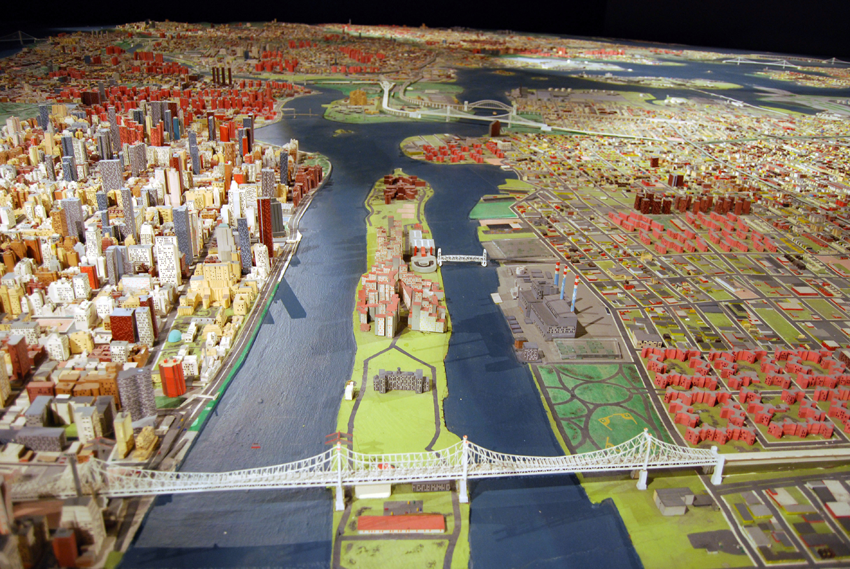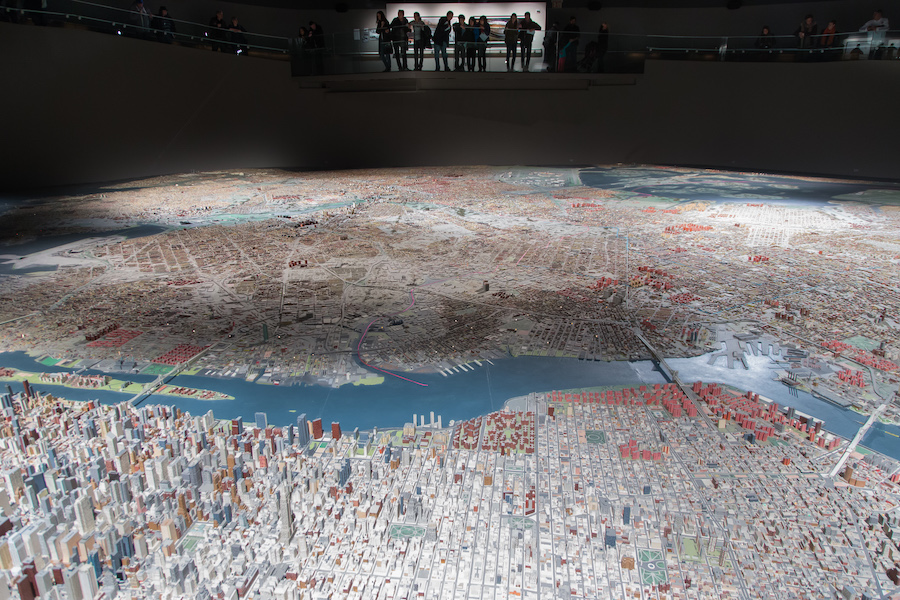Exhibitions - The Panorama of the City of New York
The Panorama of the City of New York
On Long-Term View
Image: Roosevelt Island on The Panorama of the City of New York. Photo: Max Touhey.
The Panorama of the City of New York is the jewel in the crown of the Queens Museum collection and a locus of memory for visitors from all over the globe. Conceived as a celebration of the City’s municipal infrastructure by World’s Fair President Robert Moses for the 1964-65 Fair, The Panorama was built by a team of more than 100 people working for the great architectural model makers Raymond Lester & Associates over the course of three years.
Lester was familiar with building larger-than-life model environments, having worked with Norman Bel Geddes as an artist, designer and fabricator for the 1939-40 New York World’s Fair, and later, on other large scale models of civic projects for Moses. In planning the model, Lester referred to aerial photographs, Sanborn fire insurance maps, and a range of other City material as the Panorama had to be accurate, with the initial contract demanding less than one percent margin of error between reality and the “world’s largest scale model.” Comprising an area of 9,335 square feet and built to a scale of 1:1200 where one inch equals 100 feet, the Panorama is a metropolis in miniature. Each of the city’s 895,000 buildings constructed prior to 1992 and every street, park and some 100 bridges are represented and assembled onto 273 individual sections comprising the 320 square miles of New York City. In this miraculously scaled cityscape, the borough of Manhattan measures a seemingly vast 70 x 15 feet and the Empire State Building is a towering 15 inches tall while the Statue of Liberty is only 1-7/8 inches in height. Long Island and New Jersey peek onto the model as black shadowy masses to the east and west.
When introduced in 1964, The Panorama’s special features included a continuous lighting cycle that went from dawn to dusk to night. In addition, an automated program of 3,172 colored lights highlighted the City’s municipal buildings – police precincts, firehouses, schools, hospitals, courthouses, libraries, public housing projects, as well as water, gas and electric stations. Black light fixtures mounted a few feet above the surface of the model illuminated trees and grounds of the city’s parks and the windows of Manhattan’s skyscrapers, all painted with phosphorescent paints that glowed green in the “night” cycle. Other special effects in The Panorama included moving airplanes that took off and landed at LaGuardia Airport every few minutes.
The original materials used to construct The Panorama itself are a sign of the times in which it was built – Formica panels and Urethane foam mounted on wood. The buildings were constructed of wood, plastic and hand painted paper, and the bridges of etched brass. Ongoing building additions are made by architectural model makers of laser cut/etched acrylic generated from computer aided designs.
The Panorama was one of the most successful attractions at the 1964-65 World’s Fair, with millions enjoying what was billed as an indoor helicopter tour of New York. The nine minute ride provided a “god’s eye” view of the complex topography of the five boroughs and their waterways, allowing sightseers to view the City at sea level and from a simulated 20,000 foot elevation. The “helicopters,” molded plastic tracked cars that encircled the model, also came with a guided tour, “The City of Opportunity,” read by broadcast legend Lowell Thomas which you can listen to here. The ride was a bargain at 10 cents per person while the design and construction of the entire Panorama cost $672,662.69 in 1964, the equivalent of approximately $5 million today.
After the Fair, The Panorama and helicopter ride remained open to the public for three or four years, its originally planned use as an urban planning tool seemingly forgotten. To keep up with the rapidly evolving development of the City, updates were accurately recreated in the model by Lester’s team in 1967, 1968, 1969 and 1974. Though the Queens Museum opened in 1972, only sporadic changes were made in the intervening years solely due to donations from architects and developers. During the 1980s boom in construction, models of the AT&T (Sony), Citicorp and other buildings were donated and placed on the model, though most public works and City projects were not included.
In 1992, Lester & Associates was again enlisted, this time to bring the entire model up to date. While the Museum itself was closed for a two-year renovation designed by Rafael Viñoly, the entire model was removed, with each of the 273 4’x10’ sections updated using 5,000 maps, 109 aerial photographs and site field trips to determine current conditions. In the end, more than 60,000 buildings were replaced before each panel was reinstalled in time for the Museum’s November 1994 re-opening. At this time, the helicopters, having exceeded their expected lifetime, were removed and replaced with a series of glass balconies and gently sloping ramps that mimicked the original tour of 1964. By revealing the open space and soaring vaulted ceiling of this massive “room,” the Viñoly design embraced the viewers’ need to experience New York City on a personal block by block level as well as the grand, overarching vision of Robert Moses the planner/builder and his achievements.
In the spring of 2009, the Museum launched its Adopt-a-Building program aimed at securing the future of the model while simultaneously bringing it up to date. For as little as $100, real estate on The Panorama can be “purchased,” with property owners receiving a deed in exchange for their donation. Hundreds have commemorated first date locations, elementary schools, first homes, and parents’ businesses by adopting a building. On a larger scale, the installation of new buildings on The Panorama – including Citi Field, Yankee Stadium, Brooklyn Bridge Park, Newtown Creek Wastewater Treatment Plant, 27 buildings in Battery Park City – allow recent additions to the urban landscape to be reflected while funding the ongoing care, maintenance and educational programming that brings the magic of New York to thousands each year.
El Panorama de la Ciudad de Nueva York es un modelo a escala de los cinco distritos creado para la Feria Mundial de 1964–65 y es la principal atracción de la colección del Museo. Concebido como una celebración de la infraestructura municipal de la ciudad por el intelectual del urbanismo y presidente de la Feria Mundial Robert Moses, el Panorama es un epicentro de la memoria para visitantes de todo el mundo.
Discover Images of the Exhibition
Learn more about the exhibition
Supporters
Major funding for the 2017 relighting of the Panorama of the City of New York was generously provided by Amazon Studios. Significant in-kind support provided by Crystal Window and Door Systems and Knight Electrical Services Corp. Very special thanks to Battery Park City Authority, Brooklyn Bridge Park Corporation, Jack and Dorothy Kupferberg Family Foundation, New York City Department of Environmental Protection, Mayor’s Fund to Advance New York City, New York Mets Foundation, Radii Inc., and the hundreds of donors to the Adopt A Building Program for their support of the ongoing care and maintenance of the Panorama.
The Queens Museum is housed in the New York City Building, which is owned by the City of New York.
The Museum is supported, in part, by public funds from the National Endowment for the Arts, the Institute of Museum and Library Services, the New York State Council on the Arts with the support of Governor Kathy Hochul and the New York State Legislature, and the New York City Department of Cultural Affairs, in partnership with Mayor Eric Adams, the Queens Borough President Donovan Richards, and the New York City Council under the leadership of Speaker Adrienne E. Adams.
Major funding is generously provided by Bloomberg Philanthropies, Ford Foundation, Hearst Foundations, Jerome Foundation, Lambent Foundation, MacMillan Family Foundation, Mellon Foundation, E.A. Michelson Philanthropy, New York Community Trust, Richmond County Savings Foundation, and Rockefeller Brothers Fund.
The Queens Museum would like to thank Battery Park City Authority, Brooklyn Bridge Park Corporation, Jack and Dorothy Kupferberg Family Foundation, New York City Department of Environmental Protection, Mayor’s Fund to Advance New York City, New York Mets Foundation, Radii Inc., The Achelis & Bodman Foundation, and the hundreds of donors to the Adopt-A-Building Program for their support of the ongoing care and maintenance of the Panorama. Major funding for the 2017 relighting of the Panorama of the City of New York was generously provided by Amazon Studios, the New York City Department of Citywide Administrative Services, with additional in-kind support provided by Knight Electrical Services Corp.



















